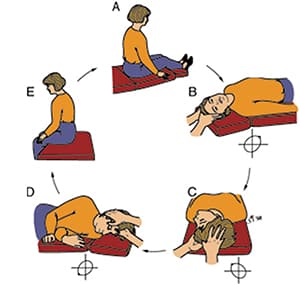Being dizzy can put you in a tizzy. You might feel woozy after Pilates or unsteady on your feet when you suddenly stand up. The world might feel like it’s whirling around you, making you feel nauseated and cause you to vomit. The symptoms may seem scary, but medical specialists know how to track down what is causing them.
“First we get patients to describe their dizziness to see if it’s an ear problem, a brain or neurological problem, blood pressure fluctuations, medical dizziness, stress or other causes,” says Timothy Hain, MD, an otoneurologist at Northwestern Medicine and the Chicago Dizziness and Hearing practice.
One of the most common causes of dizziness, Hain says, is Benign Paroxysmal Positional Vertigo (BPPV) experienced by 2.4 percent of the population every year. People with BPPV may get the brief sensation that the world is spinning around them when they roll over in bed or get out of bed (known as the bed spins), and they may even feel nauseated. They might experience BPPV when they try to get something off a top shelf (top shelf vertigo) or when they put their head back to serve a tennis ball, sit in a dentist’s chair or get a shampoo in a hair salon. They may even feel dizzy when they are holding positions in yoga or Pilates when their head is far back and extended.
“The more technical way of looking at it is that it happens when a person is reorienting their head with respect to gravity,” Hain explains. “BPPV is due to loose calcium particles, sometimes called ear rocks, rolling around inside the inner ear. When they move from one place to another, they tug on the sensitive part of the ear and give the person the illusion they are spinning, so the particles have to be rolled back into the insensitive part of the ear.”
To treat BPPV, a medical professional moves a patient’s head in a series of different directions called Epley maneuvers, developed in the 1980s by ear surgeon John Epley. “When it was just starting in the mid-’80s, we used to call it voodoo because we were a little dubious, as was most of the medical profession. But now we’re true believers,” Hain says. “You can often cure someone of their BPPV in 15 minutes.”
Epley maneuver. Courtesy of Chicago Dizziness and Hearing

“You should really know that you have BPPV before using the home exercises. [You need to] make sure that they are the appropriate treatment and [determine] whether you should be doing the exercises for the right or left side and [determine] that the dizziness is not due to low blood pressure or a brain tumor.”
Because there are many causes of dizziness, it’s important to get the correct treatment, echoes Jenny Bernieri, a physical therapist at Peak & Balance Centers of America who specializes in vestibular (inner ear) rehabilitation.
Bernieri says she sees patients with vertigo almost every day. She also treats patients experiencing dizziness after head injuries and concussions. “Sometimes it takes a specific type of rehabilitation to get these people back on track,” she says.
An array of testing equipment can be used to identify the cause.
“In general, I want to determine if the dizziness is coming from the inner ear or the brain,” Bernieri says. She first listens to patients describe their symptoms and then might watch their eye movements as they follow her finger with their eyes. She might use a low-tech tuning fork to determine how well they perceive sound or use high-tech infrared goggles to watch their eye movements.
“[The goggles] may be the most important tool I use when evaluating dizzy patients,” she says. “They allow me to see a patient’s eye movements in the dark when there isn’t anything [for them] to look at. What I see during this part of the evaluation gives me a good idea of what is causing the symptoms and how to treat them.”
Diabetics with low blood sugar, individuals with low blood pressure and people who have migraines also can experience dizziness, Hain states. Another cause can be Meniere’s disease, in which people experience dizziness as well as gradual loss of hearing in one ear and sometimes ringing in the ears.
“[Meniere’s] is a lifelong condition that usually comes and goes and gradually worsens until the person becomes deaf in one ear,” Hain explains. “It is unpredictable. The person may be doing perfectly well for a few months and then, out of the blue, everything starts to spin, and the person vomits and is out of commission for a couple of days.”
“It’s hard to control because we don’t have effective ways to prevent it, so, often you have to wait until after an attack and try to knock it down with medicine,” he says. Lifestyle changes, including a low-salt diet, can also help control Meniere’s.
With so many causes for dizziness, it makes sense to seek out a specialist to get the correct diagnosis and treatment in order to live life on an even keel.
“I’ve seen people who have had [BPPV] for 10 years and didn’t know they could get help for it,” Bernieri says. “I wish people knew how important it is to go to the right place to get it checked out.”

Nancy Maes, who studied and worked in France for 10 years, writes about health, cultural events, food and the healing power of the arts.










